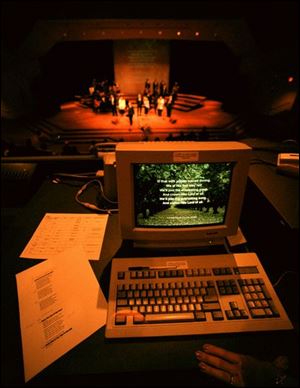
Churches, especially progressive ones, go for top sound systems
11/4/2000
A computer displays lyrics that are projected onto a screen on the stage at Wetgate Chapel.
When Cedar Creek Community Church builds its new church in Perrysburg in the next two years, don't expect to see ornate stained-glass windows or a soaring bell tower. But when the music starts, prepare to be wowed.
Cedar Creek, a nondenominational, burgeoning congregation that meets in Perrysburg Junior High School, puts a high premium on quality sound, a trend that is making itself heard in more and more churches. Over the last 20 years, sound technicians say, sound systems have moved from the bottom to near the top of the ladder in many churches, especially those with a more progressive bent.
At Cornerstone Church in Maumee, for example, sound is the No. 2 priority after saving souls, said Hall Williams, technical director of the congregation's sound ministry. The 2,500-seat church's 10,000-watt system is frequently mentioned in casual rankings of top church systems locally along with Westgate Chapel and Friendship Baptist in Toledo and Bowling Green's Dayspring Assembly of God.
Cornerstone's system consists of 12 “flown” (hanging from the ceiling) speakers, 10 platform speakers, each with a different monitor mix, and a multitude of wireless microphones, all controlled by a technical team working out of two ground-floor sound booths.
“You have to be able to hear the voice clearly, distinctly, and not with listener fatigue, so you can receive what God is saying to you,” said Mr. Williams, a sound engineer and former reggae concert promoter. “A better sound system helps you receive as a listener what God's trying to say. The technical requirements of the world are so demanding. It's even more demanding in the church sound environment.”
Lee Powell, pastor of Cedar Creek, agrees. That's why, he said, “With the sound system, the sky's the limit.” Cedar Creek expects to spend about $250,000 of its $6 million construction budget on sound and lighting in the new building.
Already, Cedar Creek has about $20,000 invested in sound equipment for its temporary quarters in Perrysburg Junior High School. About $5,000 of that will remain in the school's auditorium as a donation when the new church is built at Lime City and Mandell roads.
“We're trying to communicate to an unchurched populace who are very literate when it comes to music, sound, and lighting,” Mr. Powell said. “This is a high-tech generation and you can't trick them. To communicate effectively with them, you need to communicate with excellence ... The message we're proclaiming week after week is the single most important message spoken on the face of the Earth and we feel it deserves the best treatment.”
The willingness of churches like Cedar Creek and Cornerstone to invest in sound is part of a movement that started locally with black Baptist churches and spread to other congregations, said Ned Ludlum, a church technology consultant.
Today, he said, most churches, temples, synagogues, and mosques are aware of the importance of good sound and try to do what they can to enhance it.
The churches that are putting the most into sound, along with lighting and video, tend to be more progressive in the way they preach the gospel.
However, even more traditional churches, many of which are offering alternative contemporary services, have boosted their sound systems. As part of a recent renovation, Perrysburg's Zoar Lutheran added a Bose sound system with about 3,000 watts of power and subwoofers beneath the pews.
“It's impressive,” said Paul Taylor of Torrence Sound in Perrysburg. The Collaborative, a local architectural firm, helped design the speakers into the space. “They were interested in aesthetics, but they ended up with a high-power sound system, which is a little unusual for a Lutheran church.”
The Rev. Rick McGee, former minister of music at Glass City Christian Fellowship, said with the addition of state-of-the-art equipment, churches need qualified sound technicians to run it.
“The sound system is only as good as the person running the sound. There are guys that know the equipment in and out, know every dial, what every control is, and know about sound reinforcement, but don't have an ear to run systems, to mix harmony, to mix the piano and the drums and the bass and all the vocalists.
“Even with a poor sound system, if you've got a good sound guy, he can make the best out of it. In my opinion it's guys that are musicians or singers. I think some musicians make the best sound men, because they know what they're listening for. They know how to hear harmony and who's leading and how to mix the instruments so they complement one another.”
Mr. Ludlum said there are still factions of churchgoers who disdain sound systems and prefer the purity of unamplified acoustic sound. In this vein, he said, some churches, he said, have even torn out carpeting to “enliven” specific areas for their choirs.
Churches that opt for high-tech sound systems should expect to spend $40 to $60 per seat, he said. This would include sound in the sanctuary, speakers under and over the balcony, digital processing, a complete set of microphones, personal monitors, and recording and duplication equipment.
The result, Cornerstone's Mr. Williams said, can rival what churchgoers might hear at a concert. “We try to make it that way. I personally like to have a very warm sound ... I like to feel it. It puts me in a concert atmosphere.”